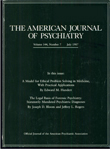Social Phobia Subtypes in the National Comorbidity Survey
Abstract
OBJECTIVE: This article presents epidemiologic data on the distinction between social phobia characterized by pure speaking fears and that characterized by other social fears. METHOD: The data come from the National Comorbidity Survey (N=8,098). Social phobia was assessed with a revised version of the Composite International Diagnostic Interview. RESULTS: Latent class analysis showed that the brief set of social fears assessed in the survey can be disaggregated into a class characterized largely by speaking fears and a second class characterized by a broader range of social fears. One-third of the people with lifetime social phobia exclusively reported speaking fears, while the other two-thirds also had at least one of the other social fears assessed. The vast majority of the latter had multiple social fears including, in most cases, both performance and interactional fears. The two subtypes were similar in age at onset distribution, family history, and certain sociodemographic correlates. However, the social phobia characterized by pure speaking fears was less persistent, less impairing, and less highly comorbid with other DSM-III-R disorders than was social phobia characterized by other social fears. CONCLUSIONS: Further general population research assessing more performance and interaction fears is needed to determine whether social phobia subtypes can be refined and whether the subtypes are better conceptualized as distinct disorders. In the meantime, people who have social phobia with multiple fears, some of which are nonspeaking fears, appear to have the most impairment and should be the main focus of prevention and intervention efforts.



